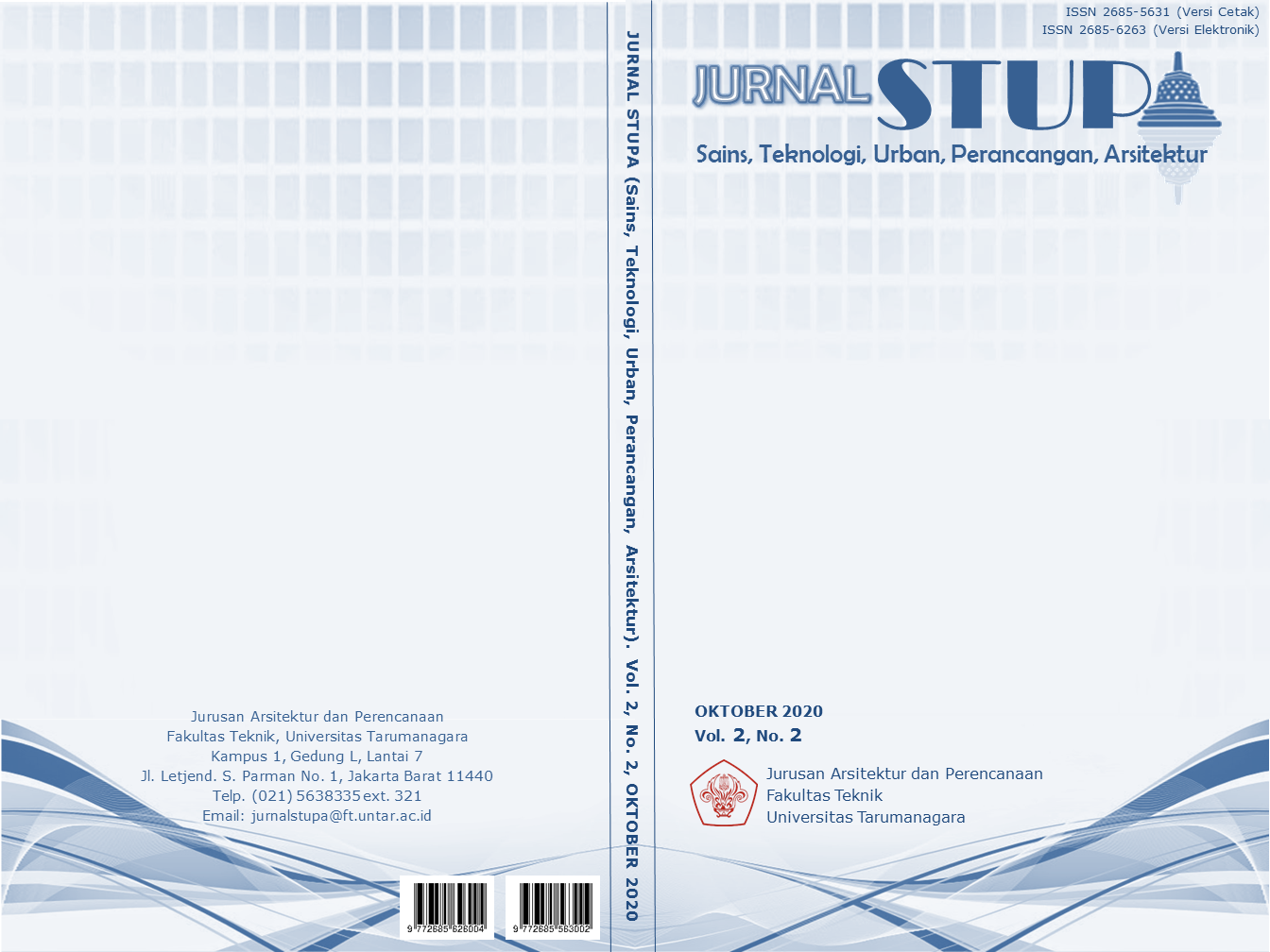PISANGAN NUANSA RETRO
Main Article Content
Abstract
Urban society is a modern society that has daily mobility and high routines and activities. This daily life then guides the city community with an all-practical lifestyle. The lifestyle demands of the urban community often demand to face a job and activity that takes up so much time that it often makes people forget about other needs including rest. This study aims to address the needs of the community, especially the East Pisangan community which is one of the areas in Pulo Gadung sub- district dominated by housing, land allotment used for housing / housing that is equal to 89.63% and the rest is used for roads, green lanes / parks , and lakes, this problem is then exacerbated by the eviction of the flea market which is the center of community gathering, then with a minimal amount of land which is then earmarked for open space and space to gather, through the role of architecture it is hoped that it can create a commercial space in the form of a flea market which is a place rest and communicate between residents so that people can have space to interact comfortably with each other. In this research the methods used are: first, conducting studies and observations; secondly, studying and reviewing the needs of the surrounding community and the need to relieve boredom and rest in the midst of a dense activity; third, compile the program in accordance with the results of the survey, observation and answer the community's needs so that the project objectives will be achieved.
Keywords: Architecture; Needs; Rest; Society
AbstrakMasyarakat kota merupakan masyarakat modern yang memiliki keseharian dengan mobilitas serta berbagai rutinitas dan aktivitas yang tinggi. Keseharian ini kemudian menuntun masyarakat kota dengan gaya hidup serba praktis. Tuntutan gaya hidup masyarakat kota sering sekali menuntut untuk menghadapi suatu pekerjaan dan kegiatan yang begitu menyita waktu sehingga sering sekali membuat masyarakat lupa akan kebutuhan lainnya termasuk istirahat. Penelitian ini memiliki tujuan untuk menjawab kebutuhan masyarakat , terutama masyarakat Pisangan Timur yang merupakan salah satu daerah di kecamatan Pulo Gadung yang di dominasi oleh perumahan, peruntukan lahan yang dipergunakan untuk pemukiman/perumahan yaitu sebesar 89.63% dan sisanya dipergunakan untuk jalan, jalur hijau/taman, dan danau, masalah ini kemudian diperburuk dengan adanya penggusuran pasar loak yang merupakan pusat berkumpulnya masyarakat, kemudian dengan minimnya jumlah lahan yang kemudian di peruntukan untuk ruang terbuka dan ruang untuk berkumpul, melalui peran arsitektur diharapakan dapat menciptakan ruang komersial berupa pasar loak yang menjadi tempat beristirahat dan berkomunikasi antar penghuni sehingga masyarakat dapat memiliki ruang untuk saling berinteraksi dengan nyaman. Dalam penelitian ini metode yang digunakan adalah pertama, melakukan studi dan observasi; kedua, mempelajari dan meninjau kebutuhan dari masyarakat sekitar serta kebutuhan untuk melepas kejenuhan dan beristirhat ditengah aktivitas yang padat; ketiga, menyusun program sesuai dengan hasil survei, observasi serta menjawab kebutuhan masyarakat sehingga tujuan proyek akan tercapai.
Article Details
References
Kubis, M. (2011). Exploring The Relationship Between The Work of Kengo Kuma and The Philosophy of Jean-Paul Sartre. Retrieved February 10, 2020, Research Report.https://www.scribd.com/doc/218 694053/The-Work-of-Kengo Kuma-andthe-philosophy-fo-Jean-Paul Sartre.
McLaren, D., Agyeman, J. (2015). Sharing Cities: A Case for Truly Smart and Sustainable Cities, MIT press
Mikunda, C. (2007). Brand lands, het spots & cool spaces Welcome to the third place and the total marketing experience. London: Kogan Page
Moore, J. (2012). The art of the Third Place in a First Suburb.
Mubayyinah, M dan Utomo, C. (2012). Analisa Highest and Best Use(HBU) Lahan X Untuk Properti Komersial. Jurnal Teknik ITS, 1(1), D16-D19. Diakses 11 Februari 2020, https://docplayer.info/50391792-Jurnal-teknik-its-vol-6-no-1-2017-issn-print-d-73.html
Oldenburg, R. (1999). The great good place: Cafes, coffee shops, bookstores, bars, hair salons and other and other hangouts at the heart of a community. New York, NY: Marlowe & Company
Oldenburg. R. (2001). Celebrating the third place: inspiring stories about the "great good places" at the heart of our communities. New York, NY: Marlowe & Company.
Pulvers, Roger. (2013). Architect Kengo Kuma: ‘A Product of Place’. The Asia Pasific Jurnal, Vol.11. Hal.3, diakses 10 Februari 2020, https://apjjf.org/2014/11/26/RogerPulvers/4141/article.html
Riccarton McGlynn, S, Smith, G, Alcock, A, Murrain, P, Bentley,I. (1985). Responsive Environments a Manual For Designers. London: Architectural Press.


